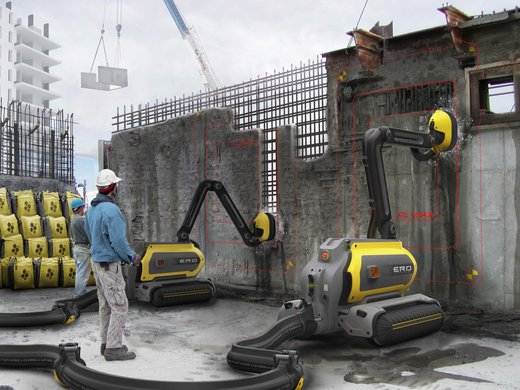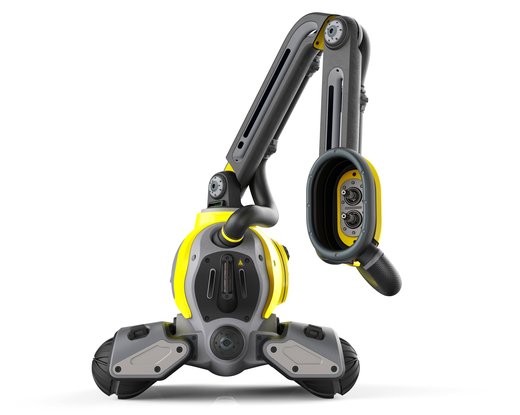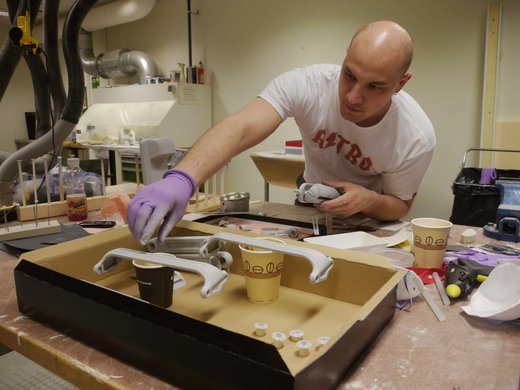31 July 2013
Imagine a robot that thoughtfully munches away at structures, digesting the concrete and efficiently excreting clean, reusable aggregate and cement. As Rod Sweet reports, somebody has.
It would keep millions of tonnes of waste out of landfill and leave smooth, exposed rebar to be snipped and taken away.
It would transform our current, energy and water intensive approach to demolition.
Like Leonardo Da Vinci’s helicopter, proposed in the 1480s, the concrete-eating deconstruction robot is just an idea at this stage, but its inventor believes the real thing is only a few years away.
Turkish designer Omer Haciomeroglu’s concept has won a gold medal in America, while its development has been supported by construction equipment manufacturer Atlas Copco Rockdrills AB.
The “ERO” (for “eroder”) first emerged as a thesis topic while Mr Haciomeroglu pursued a Master’s degree at Sweden’s UmeÃ¥ Institute of Design.

Artist’s rendition of the self-propelled concrete-eating robot at work (Omer Haciomeroglu)
But it has since captured international attention, winning a gold medal this year from the Industrial Designers Society of America (IDSA).
Atlas Copco provided approximately $7,600, plus technical support, for Mr Haciomeroglu to develop the idea.
The way it would work is reminiscent of the hit film, WALL-E.
Mr Haciomeroglu says the autonomous ERO would be placed strategically in the building. It would scan its surroundings, determine a route, and start “erasing” the structure.
At the muncher head, the concrete is broken up with concentrated jets of high-pressure water, while powerful suction captures the slurry of aggregate, cement and water.
Inside, a centrifugal decanter separates and filters the ingredients and sends each down a separate tube for further processing.
The clean aggregate gets packed into big bags, ready for re-use.
It may be just a concept at this stage but Mr Haciomeroglu says the ERO is, technically, well within our grasp.

A model of ERO. All the technologies proposed exist today, says Omer Haciomeroglu (Omer Haciomeroglu)
Centrifugal decanters, for instance, are used widely to separate solids from fluids in other industrial processes.
“I really wanted to keep it a real near-future concept, so I looked at existing technologies,” he told GCR. “I found some and thought about how to combine these and make them work together.”
“All the concept needs is money, and good team of engineers,” he added. “It would take three years, four, tops, because all the technologies, everything on ERO, actually exists today.”
Cute
The look of the ERO – as a friendly, helpful, robotic creature – was deliberate as well, Mr Haciomeroglu said.
You might think an optimum design for a building-eating contraption would be much bigger and uglier, like a tunnel boring machine.
Not necessarily, says Mr Haciomeroglu.
“It depends on whether you’re eating like Godzilla or a termite,” he said.
“When we think of demolition today we think of almighty, giant, powerful machinery attacking the building, reducing it to rubble and dust. Demolition service providers use brute force to get the job done as fast as possible, not caring how much waste they create or dust pollution.

Omer Haciomeroglu, graduate of Sweden’s UmeÃ¥ Institute of Design, at work in his studio (Omer Haciomeroglu)
“The idea here is, you can either attack the building or remove it strategically. I wanted something much friendlier, that looks smarter, cute – more brainy than brawny.”
He added that this version of the ERO is a “role model” that would lead to a larger fleet of products with different specs, including bigger EROs for recycling bridges, or smaller ones for concrete tubes.
What the future holds is unclear, but he said that since the IDSA award he has started receiving emails from companies all over the world wanting to know more.
“There is a big, big demand, globally, so I’m going to be talking to them and we’ll see what happens.”
See: IDSA






